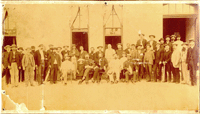|
|
John Ireland (1827-1896), governor and legislator, son of Patrick and Rachel (Newton) Ireland, was born near Millerstown, Kentucky, on January 21, 1827. He served for several years as constable and sheriff of his home county, began to study law in 1851, and was admitted to the bar in 1852. He established himself at Seguin, Texas, in 1853. Ireland, mayor of Seguin in 1858, was a delegate to the Secession Convention in 1861; he voted for secession. He volunteered as a private in the Confederate Army in 1862 and advanced to the rank of lieutenant colonel. He was stationed on the Texas coast at the end of the war. He was a member of the Constitutional Convention of 1866 and served as district judge in 1866-67. He was removed by Philip Sheridan as an "impediment to Reconstruction." Ireland was elected to the House of the Thirteenth Legislature and to the Senate of the Fourteenth Legislature. As a legislator he opposed granting lands and subsidies to railroads, his work against the grant to the International-Great Northern Railroad winning him the sobriquet "Oxcart John." He served as associate justice of the Texas Supreme Court from 1875 until the Constitution of 1876 reduced that body from five to three judges. He was unsuccessful as a candidate against Richard Coke for the United States Senate in 1876 and against Gustav Schleicher for the United States House in 1878.
He married Mrs. Matilda Wicks Faircloth in 1854. After her death in 1856, he married Anna Maria Penn in 1857. He had three daughters and later adopted his daughter's son, Patrick Ireland Carpenter. Ireland was a Mason and a Presbyterian. After his retirement from the governorship, he practiced law in Seguin until his death, on March 15, 1896. BIBLIOGRAPHY: Harbert Davenport, History of the Supreme Court of the State of Texas (Austin: Southern Law Book Publishers, 1917). Galveston News, March 16, 1896. Vertical Files, Barker Texas History Center, University of Texas at Austin. Claude Elliott Reprinted with permission from the Handbook of Texas Online, a joint project of the Texas State Historical Association and the General Libraries at the University of Texas at Austin. © 2003, The Texas State Historical Association.
|

